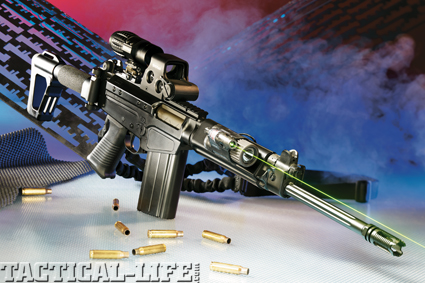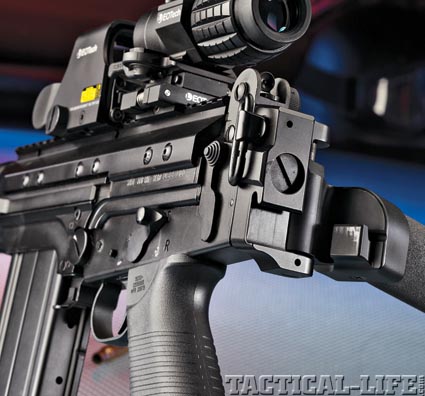The Para Tactical is shown equipped with an EOTech XPS2-0 HWS backed up by an EOTech G23.FTS 3X magnifier unit on a flip-to-side mount. Mounted on the forend is an Insight Technology M6X-G white light/green laser unit.
When it comes to military pedigrees, few designs can hold a candle to the FAL-pattern rifle. Developed by the famed Fabrique Nationale (FN) chief arms designer, Dieudonné Joseph Saivé, the Fusil Automatique Léger (or “light automatic rifle”) earned the distinction of being adopted by nearly 100 countries during the Cold War era, and seeing service on both sides of many conflicts in that time of seemingly unending proxy wars. In fact, in regards to total numbers produced, the FAL easily outshines the now-dominant M16/AR-15 series, and comes in second only to the ubiquitous Kalashnikov for sheer profligacy.
So, would it not make sense for a battle-proven warrior such as the FAL to be adapted to today’s law enforcement needs? For obvious reasons, the AR carbine is the “top dog” today in law enforcement circles, due in no small part to its U.S. military pedigree as well as the broad availability of parts and accessories. Another consideration is the fact that the lion’s share are made right here in the United States. So, you can see how a Belgian-born military design could have trouble getting a foothold in U.S. law enforcement.
Advertisement — Continue Reading Below
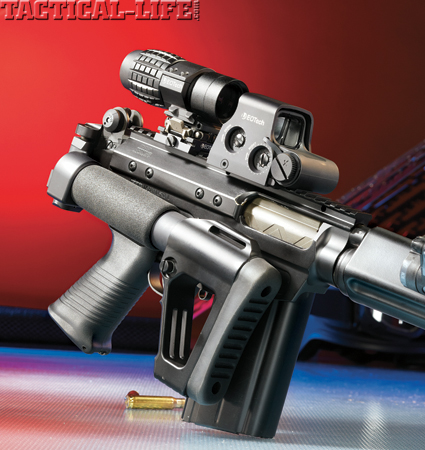
The Para Tactical featured a side-folding ACE Ltd. SOCOM stock adjustable for length of pull. The stock locks solidly and allows for ease of storage of the carbine.
That would be true if it were not for the efforts of DS Arms, a manufacturer of primarily metric FAL-pattern rifles. In fact, the company offers many variants that are right up the alley of an LE officer looking for a powerful, reliable and capable .308 patrol/tactical carbine. One of them, the SA58 Para Tactical, is the subject of this piece. But more on that in a moment.
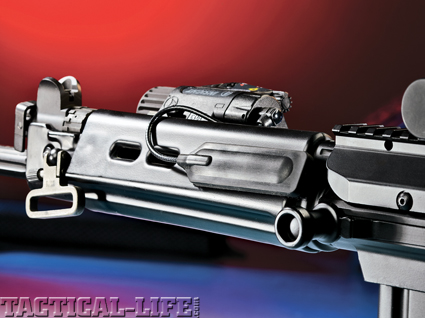
The shortened gas system of the Para Tactical measures 8.5 inches. Note the pressure switch of the Insight Technology M6X-G.
Advertisement — Continue Reading Below
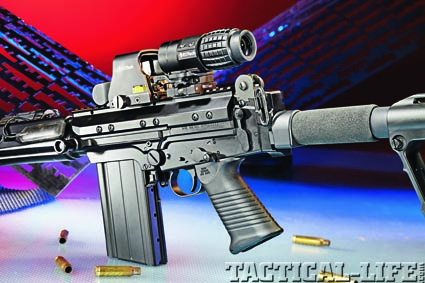
The manual safety of the DS Arms SA58 Para Tactical is located above the SAW-style pistol grip of the carbine.
U.S. FAL Rifles
So how did a U.S.-based manufacturer come to produce FAL rifles that, in the opinion of many well-informed experts, possibly exceed the quality of the original FN-manufactured versions? There is an interesting story behind that. DS Arms has a long history with the FAL rifle, beginning in the late 1980s as a full-service FFL with a specialized focus in military-pattern rifles. Exhibiting a knack for digging up FAL parts treasures from around the globe, the company soon shifted its entire focus to the FAL.
Advertisement — Continue Reading Below
As luck would have it, DS Arms learned in the mid-1990s that the Steyr Arms plant in Austria that was licensed to produce the Austrian variant of the FAL, the Sturmgewehr 58 (StG 58), was to be sold off as surplus assets. DS Arms jumped, and was able to purchase original blueprints, tooling and parts for the StG 58 FAL. Shipping this all over to the United States, DS Arms set about building the foundation for the line of respected FAL-pattern rifles now knows as the SA58 Series.
And the rifles that appeared were not simple copies of the original FAL rifle, but rather new recreations of the design. They were developed with cutting-edge materials, modern manufacturing processes and configurations catering to the needs of modern-day tactical users. It is important to note that although DS Arms offers a line of rifles with standard configurations like a traditional manufacturer, they behave more like a custom builder. Each rifle can be modified, enhanced or upgraded to the purchaser’s specific requirements.
Also of note is the semi-automatic-only receiver developed by DS Arms as the foundation of the SA58 series. Machined from a billet of 4140 steel, the manufacturing process behind the receiver (including heat treating and finishing) takes a full eight hours. Receivers are offered in two primary versions: Type I and Type II. The Type I is patterned after the original FN receiver, while the Type II is patterned after the receiver that FN made from the 1960s and on that featured “lightening cuts.” As a side note, the company also produces small runs of L1A1 receivers in “inch” pattern.
Advertisement — Continue Reading Below
Although the SA58 series includes such varied offerings as an original-style StG 58-pattern FAL and Hunter Series SA58s designed for the outdoorsman, it is the Tactical Series of SA58s that should appeal to the officer looking to upgrade from a 5.56x45mm rifle.
The subject of this article, the SA58 Para Tactical Carbine, is a good example, combining not only the enhancements to the FAL design that DS Arms incorporated into the basic SA58 Series, but also some unique innovations to the platform designed to make the FAL an ultra-modern and modular .308 tactical carbine.
Although the FAL rifle has many positive attributes, light weight is not one of them. Making extensive use of machined steel parts, the original FAL was a tough, heavy brute. However, DS Arms recognized that modern LE and tactical users would want a carbine that is as light as reasonably possible. The FAL is also a long rifle, with its military-configuration barrel topping out at roughly 21 inches (not counting a muzzle device).
Advertisement — Continue Reading Below
To counter this, DS looked very closely at the front end of the SA58. The solution was to shorten it to cut both weight and length. Although the easiest solution would be to simply leave the standard-length forend and gas system and just cut back the barrel (which the company has done on some other SA58 variants), the decision was made to shorten the piston-operated gas system for the Tactical Carbine.
The benefits would be threefold. Not only would the overall length be shortened, but the weight would be decreased more drastically than simply “chopping” the barrel. In addition, the shortened gas system would allow the company to develop short-barreled rifle (SBR) variants with barrels as short as 11 inches. The result is a forend that measures a scant 8.5 inches long with a commensurately shortened gas system. However, the gas system operates the same as the standard, with the numerous adjustments and two-position gas plug (“A” for open, “Gr” for closed) of the standard Austrian FAL.
Advertisement — Continue Reading Below
To further shorten the carbine, DS Arms incorporated a side-folding stock system, as pioneered by FN, indicated by the “Para” in this particular rifle’s designation. Employing a folding stock is no simple feat on a FAL, as the original design has the recoil spring assembly extending back into the buttstock. The solution is to relocate the spring assembly above the action, under a proprietary top cover.
The stock on my sample Para Tactical was fitted with an ACE Ltd. SOCOM buttstock with five positions for length of pull adjustment over a 2-inch range of movement. The “tube” of the stock has a foam covering for a comfortable cheekweld, and the stock employs a “tongue-in-groove” locking system. To open or close, you simply push down on the body, with it locking solid in either position. To help keep weight down on the Para Tactical, and to offset the weight of the stock, DS Arms employed their lightweight aluminum lower receiver assembly.
The receiver on the sample rifle was a Type I, and it was fitted with another of DS Arms’ innovations—the Extreme Duty Scope Mount. FALs, due to their removable top cover design, do not have an enviable reputation for working well with scopes. Further agitating this was the fact that on folding stock variants, you had to remove a mounted scope to disassemble the rifle. Needless to say, maintaining a zero would be an effort in frustration. The aluminum Extreme Duty Scope Mount sidesteps these issues by allowing the Para’s guide rod and spring to be removed while the scope mount/top cover remains on the rifle. The result is a rock-solid strip of Picatinny rail along the top of the rifle that remains in place during disassembly.
Advertisement — Continue Reading Below
Further features of the sample rifle included a SAW-style pistol grip, an AR-style dual aperture winged peep rear sight unit and an attractive, deep black DuraCoat finish on the metal. The 16.25-inch medium-contour barrel of the rifle was fluted for enhanced cooling and lighter weight, and was topped off on its threaded muzzle with a Yankee Hill Machine Phantom flash suppressor. And the short, synthetic forend was equipped with a 2-inch strip of polymer Picatinny rail on its upper right side (DS Arms also offers full Picatinny rail forends as an option).
When I received the Para Tactical, I was immediately struck by the quality of its manufacture. The finish was evenly and attractively applied, and all the controls worked smoothly. Fit and finish was excellent across the board. I also noted its weight. At 8.75 pounds, it is no pencil-barreled carbine, but it is lighter than other standard FALs I have shot. In addition to a standard single 20-round FAL magazine included with the carbine, DS Arms had been kind enough to also include some of their newly manfactured 30-round magazines. These steel magazines are part of a new line of U.S.-made FAL magazines that DS Arms has developed due to concerns over surplus samples drying up. They will be offered in 20-, 25- and the included 30-round variants, and retail for a very reasonable $24.95. The 20 and 25 rounders will be released later in the year.
Operation of the Para Tactical should be familiar to anyone who has fired a FAL rifle. With an empty rifle, you rock a loaded magazine into the magazine well from front to back (like a Kalashnikov or M14/M1A). Once seated, the user charges the action by pulling back on the non-reciprocating charging knob on the left side of the action. A rotating safety lever, located above the pistol grip on the left side, is rotated up for “safe” and down for “fire” (with “S” and “R” markings, respectively).
When the rifle is empty, the follower of the magazine engages a bolt hold-open device. To release the magazine, you push forward on a grooved paddle forward and right of the triggerguard, and rock the empty magazine out. Of note is the fact that the bolt hold-open device can also act as a bolt release button. With a fresh magazine inserted, you simply pull down on a grooved extension of the device that is positioned forward and left of the triggerguard.
Advertisement — Continue Reading Below
Range Time
I took the carbine out with a 20- and two 30-round magazines and a selection of Black Hills, Federal and Winchester .308 ammunition. I topped off the scope mount with an EOTech XPS2-0 Holographic Weapon Sight (HWS) backed up by an EOTech G23.FTS (flip-to-side) magnifier unit offering 3X magnification. The magnifier’s flip-to-side mount is actuated by a spring-loaded base with a paddle release lever located on the right side.
Once I was set on the bench, I began putting the rifle through its paces at 100 yards. There were no malfunctions during this phase, and accuracy was good for a .308 carbine at this distance (in the 2.5- to 3.5-inch range on average). Recoil was stout, but not unpleasant.
Following this, I ran roughly 100 more rounds of each type of ammunition through the rifle to test it for reliability. Over these 300 rounds, the rifle ran without a hiccup. The 30-round magazines functioned perfectly, although when fully loaded they did add some noticeable weight to the SA58. Transitioning from shooting targets at 75 yards (with the 3X magnifier engaged) to targets at 25 yards (with the magnifier flipped clear of the HWS) proved to be intuitive and easy. I did note that,
although admirably light for a FAL, the Para Tactical with the EOTech optics came in at around 10 pounds empty. However, this helped tame the recoil while firing. Just remember, this is a bigger, heavier rifle than your AR.
Final Notes
All in all, I would feel confident in stating that DS Arms has developed a compact and handy variant of the FAL that is just about ideal for the patrol officer or tactical team member that wants .308 firepower in a manageably sized carbine. Combine this with the numerous uprgrades available and a base price of $1,975 (not that much more that some high-end 5.56mm ARs), and you have a winner.
